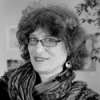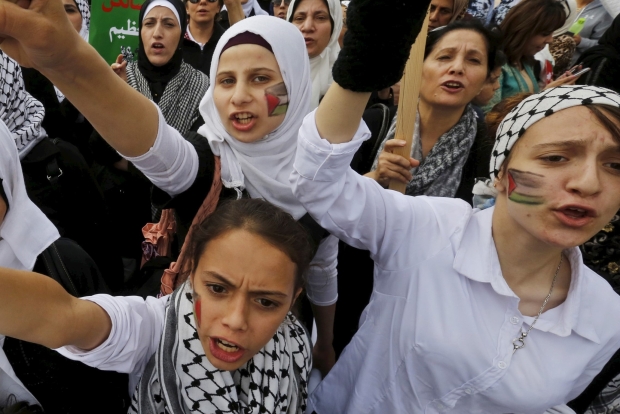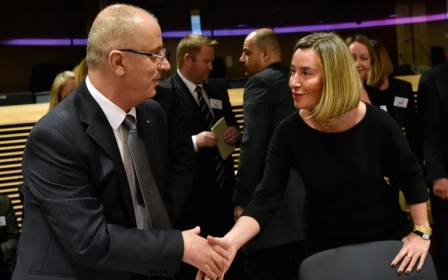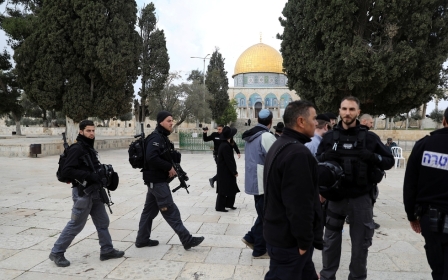Ahed Tamimi and women in the Palestinian resistance

As activists around the world take part in the Global Day of Action to Free the Tamimis on 18 February, it is only appropriate to highlight the courage that made 17-year-old Ahed Tamimi the face of Palestinian resistance.
It is also important to celebrate Palestinian women generally, and the long history of their many contributions to the struggle.
Gender matters
Ahed Tamimi is an admirable young woman who makes Palestinians and our allies proud, not because she slapped a soldier, but because, for years, she has participated in, and led, protests against the theft of her land.
She was an icon before "the slap" that resonated around the world. She has spoken articulately about the Palestinian struggle for justice, and how it is connected with other similar struggles globally.
And as Israel tries to keep the media away from her trial, we must do our part to denounce how that country treats an indigenous woman defending her land and natural resources from an illegal occupying army.
We must do our part to denounce how Israel treats an indigenous woman defending her land and natural resources from an illegal occupying army
And yes, her gender matters: Had a 17-year old boy slapped an Israeli soldier, they would have shot him on the spot, rather than initially laughed at him, only arresting him when the video of the slap went viral.
Yet as I wrote in an earlier column, while Ahed herself may be exceptional, her struggle is nevertheless typical of that of millions of Palestinians. Nor is there anything unusual about her pre-dawn arrest: Israel arrests an average of two Palestinian children per night.
As such, Ahed is representative of a multitude of Palestinian women and children whose stories are insufficiently reported.
In a sobering article published here last week, MEE editor in chief David Hearst traced the similar paths taken by a father and son, Nasr and Ahmad Jarrar, 15 years apart.
Nasr Jarrar was executed by Israeli soldiers in Jenin in August 2002, after he himself had shot at a Palestinian man being used as a human shield by Israeli soldiers invading the refugee camp. On 7 February 2018, Israeli soldiers also shot to death Nasr's son Ahmad, after he shot a settler.
"From father to son, how the Palestinian struggle is passed on from one generation to the next,” Hearst wrote, providing an informative overview of the ongoing oppression of the Palestinians, even as circumstances around them seem to change.
From mother to daugher
In addition to fathers and sons, it is important to be intentional about inscribing Palestinian women's contributions, when these are being erased by patriarchal patterns within the community, as well as the international media. Following Ahmad Nasr Jarrar's execution, a group of Palestinian women decided to organise a delegation to offer their condolences to the grieving families.
Nihaya Qawasmi, a Jerusalem-based organiser, told me in a private communication that a few women, including her, had taken the lead in organising the trip from Jerusalem to Jenin, to offer condolences to the families of the two young martyrs, Ahmad Nasr Jarrar (the younger Jarrar in Hearst's op-ed), and his cousin Ahmad Ismail Jarrar. (They had wanted to also go to the house of a third martyr, Ahmad Abu Obeid, but were denied permission to travel there).
The women leaders asked for one man and one woman, but the men insisted that two of them would speak. "We found ourselves in the awkward position of being seen as disrespectful troublemakers if we insisted that one of us should speak," Qawasmi told me.
It is important to be intentional about inscribing Palestinian women's contributions, when these are being erased by patriarchal patterns within the community, as well as the international media
"The same few men then decided there was no time to visit the second house, and even turned down a lunch prepared by one of the hosts for all 40 members of the delegation," Qawasmi continued. "Thus, over the day, three major decisions were made by men at an event initially organised by women.
"A few men became the leaders, as if we weren't there, as if this wasn't our idea, as if we weren't the ones who had made the calls and organised the delegation. A few of us women objected, the rest were demure, and suddenly, the men became the leaders, and we were just followers."
While such experiences are obviously not representative of the way all Palestinian men always treat women, they are all too frequent, and must be denounced, even as we also expose the Orientalist bias of the Western media.
Backbone of the Intifada
Going back to the First Intifada, which the Western media represents primarily with the image of young men throwing stones, we must also pay tribute to the women organisers. In the movie The Wanted 18, for example, women explain how they bought coloured cloth and sewed the Palestinian flags that people flew at rallies.
In order not to be caught engaging in this "illegal" activity, different women would take turns buying yards of one colour at a time, red, black, white, and green. They would then assemble them in another woman's house, as yet more women kept guard to warn of Israeli soldiers approaching, and distract the soldiers when that proved necessary.
"Women, when they get involved in protest movements, research shows that the movements are more likely to succeed and lead to democratic societies," Bacha explained. "When movements have as part of their ideology a call for gender equality, they tend to be more likely to adopt nonviolent strategies, and tend to be successful at leading to stable, democratic, pluralistic societies.They are longer lasting."
As Amy Zimmerman writes, in her review of the documentary: "Female activists are not shiny aberrations - they are the unseen spine holding up a movement."
Women’s persistence continues undeterred, even when they pay the highest price.
Fatima Breijeh, from Al Ma'sara, Bethlehem, has lost one son, Imad. But she affirms: "I have decided to continue to resist until the last breath and to continue to urge people to resist and to teach my children to resist and to lay the foundation for this through their milk. Our roots are fixed here. We, this land, this land, we are from this land. Look at the earth, at the soil; you will find it’s our colour."
Our spirit would have been crushed a long time ago, were it not for the women and young girls
It is no surprise, then, that Briejeh's other son, Hassan, coordinates the National Committee Against the Wall and Settlements, regularly participating in weekly protests against the neighbouring settlement of Ifrat.
Eighteen-year-old Malak Mattar, whose paintings now hang in homes around the world, epitomises creativity against the odds. Mattar, who grew up a displaced refugee in Gaza, started painting at the age of 14, to heal herself from the trauma of Operation Cast Lead, the third of Israel's massive military assaults on the Gaza Strip that she experienced at her tender age.
Agents of resistance
With her paintings, mostly portraits of women, Mattar showed the world the indomitable persistence of Palestinians, and the irrepressible urge to live a life of freedom and dignity.
These are but a handful of examples of how absolutely central Palestinian women and young girls have been in carrying on the struggle for Palestinian liberation. Our men, young and old, are essential to the resistance. But our spirit would have been crushed a long time ago were it not for the women and young girls.
And it is all the more important to inscribe their contribution to Palestinian liberation when the Western discourse, both conservative and liberal, portrays Palestinian culture as irredeemably patriarchal, as if misogyny were not a universal phenomenon, and as if Palestinian women and girls have not always been active participants in the struggle, agents of change and hope.In this context, we must foreground Palestinian women’s long history as full agents of resistance, sumud (steadfastness), and ultimately, liberation.
In Palestine, there is no distant battlefront to which armed grown men go and engage other armed grown men. There is an occupying army of male and female Israeli soldiers, and a resisting population of civilian families, loving fathers like Bassem Tamimi, determined mothers like Fatima Breijeh, fierce young women like Ahed Tamimi, and countless organisers, women, men, young and old, without whom our rights would have long ago been surrendered, negotiated away.
As we pay tribute to the Tamimis, it is time to retire the expression "women and children", which literally infantilises grown women, while erasing the gender differences between girls and boys.
- Nada Elia is a diaspora Palestinian writer and political commentator, currently working on her second book, Who You Callin' 'Demographic Threat?' Notes from the Global Intifada. A professor of gender and global studies (retired), she is a member of the steering collective of the US Campaign for the Academic and Cultural Boycott of Israel (USACBI)
The views expressed in this article belong to the author and do not necessarily reflect the editorial policy of Middle East Eye.
Photo: Palestinian Ahed Tamimi, right, campaigner against Israel's occupation, appears at a military court at the Israeli-run Ofer prison in the West Bank village of Betunia in 2016 (AFP).
This article is available in French on Middle East Eye French edition.
Middle East Eye propose une couverture et une analyse indépendantes et incomparables du Moyen-Orient, de l’Afrique du Nord et d’autres régions du monde. Pour en savoir plus sur la reprise de ce contenu et les frais qui s’appliquent, veuillez remplir ce formulaire [en anglais]. Pour en savoir plus sur MEE, cliquez ici [en anglais].








